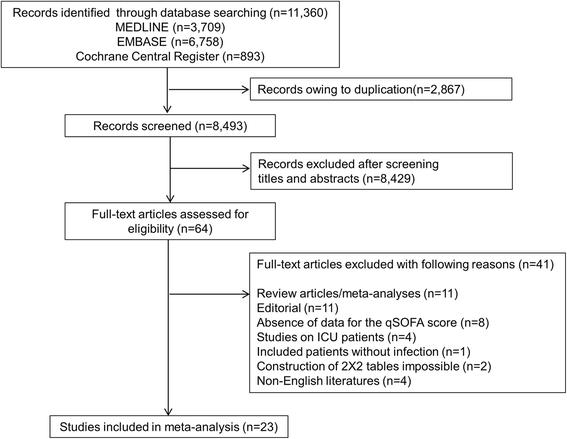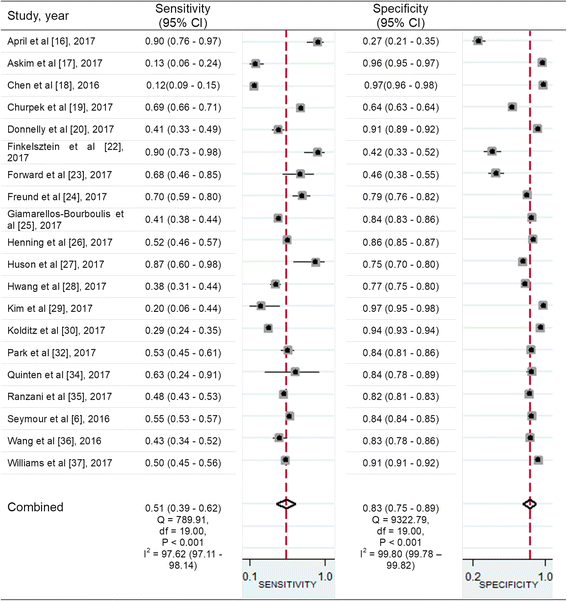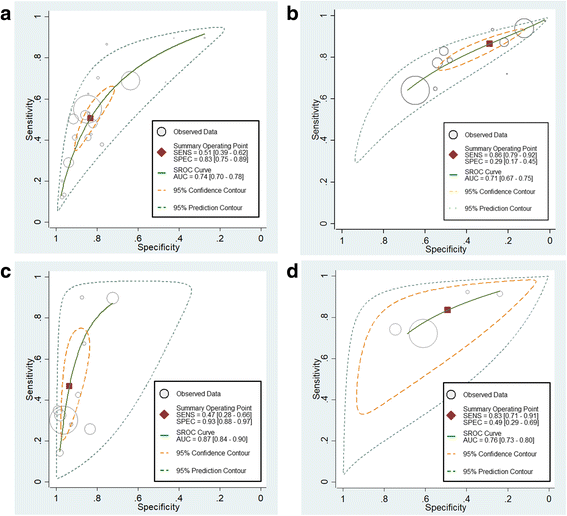Performance of the quick Sequential (sepsis-related) Organ Failure Assessment score as a prognostic tool in infected patients outside the intensive care unit: a systematic review and meta-analysis
- PMID: 29409518
- PMCID: PMC5802050
- DOI: 10.1186/s13054-018-1952-x
Performance of the quick Sequential (sepsis-related) Organ Failure Assessment score as a prognostic tool in infected patients outside the intensive care unit: a systematic review and meta-analysis
Abstract
Background: The usefulness of the quick Sequential (Sepsis-related) Organ Failure Assessment (qSOFA) score in providing bedside criteria for early prediction of poor outcomes in patients with suspected infection remains controversial. We investigated the prognostic performance of a positive qSOFA score outside the intensive care unit (ICU) compared with positive systemic inflammatory response syndrome (SIRS) criteria.
Methods: A systematic literature search was performed using MEDLINE, Embase, and the Cochrane Central Register of Controlled Trials. Data were pooled on the basis of sensitivity, specificity, and diagnostic OR. Overall test performance was summarized using a hierarchical summary ROC and the AUC. Meta-regression analysis was used to identify potential sources of bias.
Results: We identified 23 studies with a total of 146,551 patients. When predicting in-hospital mortality in our meta-analysis, we identified pooled sensitivities of 0.51 for a positive qSOFA score and 0.86 for positive SIRS criteria, as well as pooled specificities of 0.83 for a positive qSOFA score and 0.29 for positive SIRS criteria. Discrimination for in-hospital mortality had similar AUCs between the two tools (0.74 vs. 0.71; P = 0.816). Using meta-regression analysis, an overall mortality rate ≥ 10% and timing of qSOFA score measurement could be significant sources of heterogeneity. For predicting acute organ dysfunction, although the AUC for a positive qSOFA score was higher than that for positive SIRS criteria (0.87 vs. 0.76; P < 0.001), the pooled sensitivity of positive qSOFA score was very low (0.47). In addition, a positive qSOFA score tended to be inferior to positive SIRS criteria in predicting ICU admission (0.63 vs. 0.78; P = 0.121).
Conclusions: A positive qSOFA score had high specificity outside the ICU in early detection of in-hospital mortality, acute organ dysfunction, and ICU admission, but low sensitivity may have limitations as a predictive tool for adverse outcomes. Because between-study heterogeneity was highly represented among the studies, our results should be interpreted with caution.
Keywords: Emergency department; Intensive care unit; Mortality; Sepsis; qSOFA.
Conflict of interest statement
Ethics approval and consent to participate
Not applicable.
Consent for publication
Not applicable.
Competing interests
The authors declare that they have no competing interests.
Publisher’s Note
Springer Nature remains neutral with regard to jurisdictional claims in published maps and institutional affiliations.
Figures



References
Publication types
MeSH terms
LinkOut - more resources
Full Text Sources
Other Literature Sources
Medical

